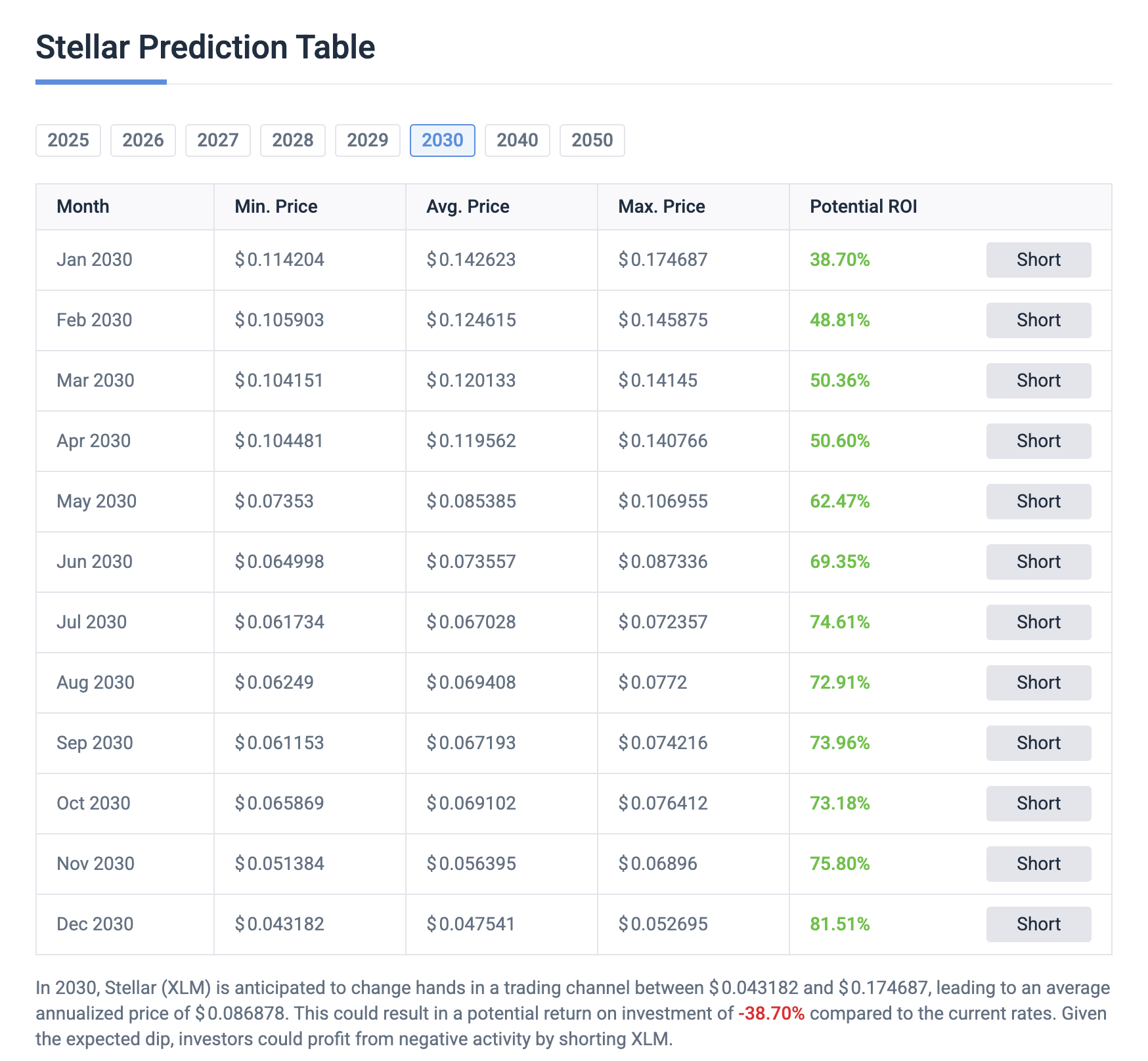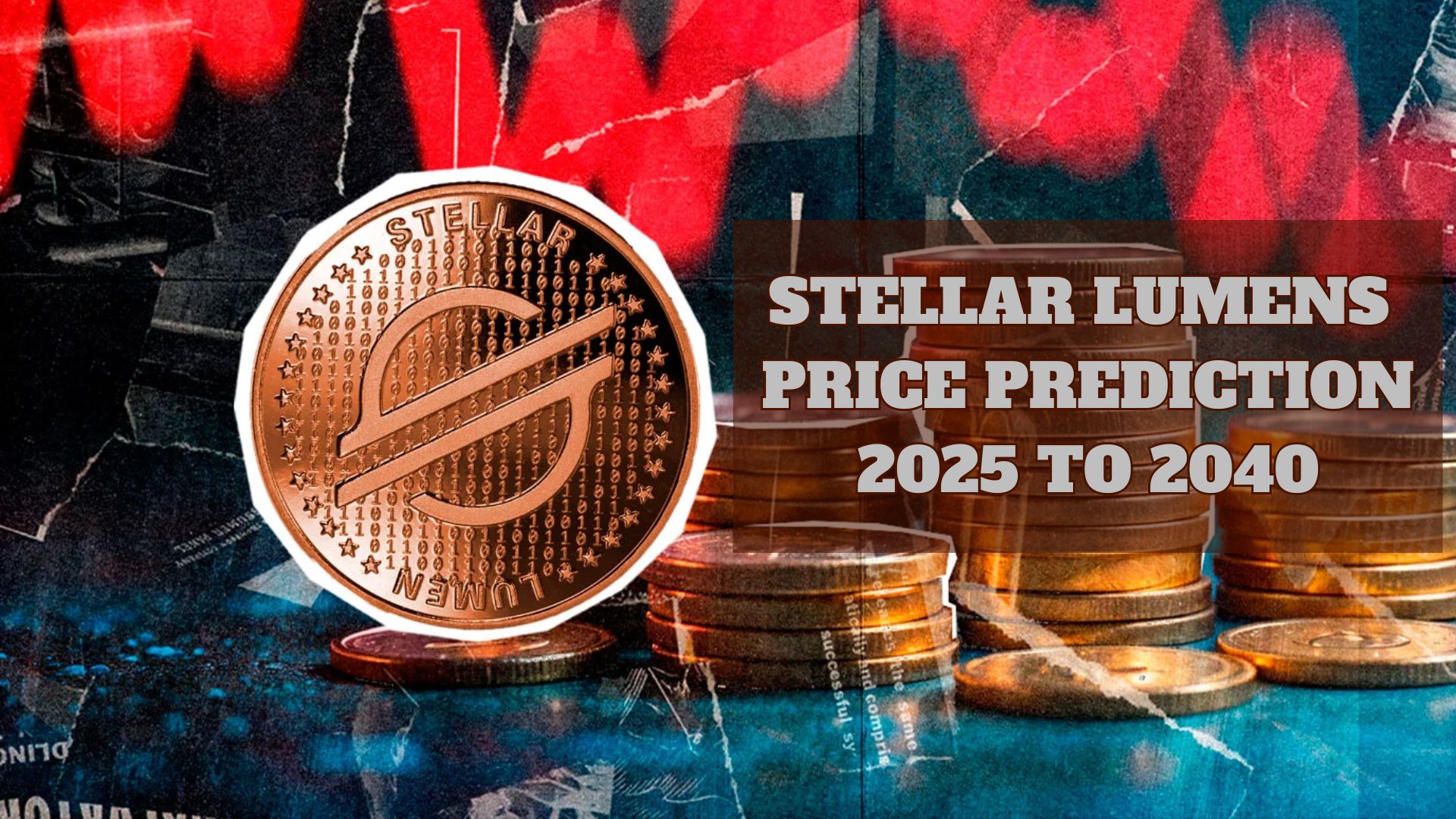Cryptocurrency markets are notoriously volatile, making it challenging for investors to predict the future price movements of assets. Among the myriad of digital currencies, Stellar Lumens (XLM) stands out as a notable contender in the blockchain space. Founded in 2014 by Jed McCaleb and Joyce Kim, Stellar aims to facilitate cross-border transactions and provide financial services to the unbanked. Since its inception, Stellar Lumens has experienced significant fluctuations in price, which naturally prompts questions regarding its future performance.
In this article, we’ll explore Stellar Lumens price predictions from 2025 to 2040, examine whether it’s a good investment, and compare it to its main competitor, Ripple (XRP).
Stellar Lumens price prediction overview
Before diving into future price predictions, it’s essential to understand what Stellar Lumens is and why it matters to investors. Stellar Lumens (XLM) is the native cryptocurrency of the Stellar network, which operates as a decentralized protocol designed to facilitate fast and low-cost cross-border transactions. Stellar’s unique consensus algorithm, called the Stellar Consensus Protocol (SCP), allows the network to process transactions more efficiently than traditional systems like SWIFT, which is why it has been gaining traction in the financial services industry.
Stellar Lumens price predictions are crucial for investors as they seek to identify trends, risks, and potential profits from their investments. Price forecasts help investors strategize on when to buy, hold, or sell an asset, considering both short-term market fluctuations and long-term growth potential.
In this analysis, we’ll break down the potential price range of XLM for the years 2025, 2030, and 2040, as well as provide a strategy for each period based on expected market trends.
Stellar Lumens price prediction 2025
Looking ahead to 2025, the cryptocurrency market is expected to experience continued growth, albeit with periodic market corrections. As blockchain technology becomes more widely adopted and more financial institutions integrate cryptocurrencies into their infrastructure, Stellar Lumens could see substantial demand, particularly in regions that are still underbanked.
| Price Range (2025) | Expected Price Range | Average Price | Potential ROI | Suggested Strategy |
|---|---|---|---|---|
| 2025 Price Prediction | $0.194086 – $0.44799 | $0.271406 | Up to 56.86% | Mixed (Buy in high ROI months, short in low ROI months) |

The projection for 2025 indicates a potential upside from the current market price, suggesting that XLM might see a moderate increase in value. The average annualized price for 2025 is projected at $0.271406, reflecting a steady increase in demand for Stellar’s unique offerings.
Potential return on investment (ROI): Based on these predictions, XLM could yield a 56.86% ROI by 2025. This is a relatively healthy return, particularly in a market as unpredictable as cryptocurrencies.
Suggested strategy: Investors should adopt a mixed strategy, taking advantage of periods with high ROI potential. These periods might occur when major partnerships or technological advancements are announced, leading to a spike in price. Conversely, shorting XLM during months of lower ROI or price corrections could help mitigate potential risks, especially during periods of market uncertainty.
Stellar Lumens price prediction 2030
As we look toward the year 2030, the landscape for digital assets will likely have evolved significantly. By this time, blockchain and cryptocurrency technology could be deeply integrated into the global financial system, but it’s also possible that only a few digital assets will remain dominant. In this context, the future of Stellar Lumens may be influenced by competition from other blockchain projects, including newer, more scalable solutions.
| Price Range (2030) | Expected Price Range | Average Price | Potential ROI | Suggested Strategy |
|---|---|---|---|---|
| 2030 Price Prediction | $0.043182 – $0.174687 | $0.086878 | -38.70% | Short XLM due to expected decline |

The projection for 2030 indicates a significant drop in price compared to 2025. With an average annualized price of $0.086878, this price forecast suggests a downtrend is expected, potentially due to increased competition, market saturation, or a lack of continued growth in the Stellar ecosystem.
Potential return on investment (ROI): The potential return for investors holding XLM through 2030 is -38.70%. This negative ROI suggests that Stellar Lumens may face considerable challenges in maintaining its value over the next decade, which could be concerning for long-term holders.
Suggested strategy: Given the expected decline in price, the strategy for 2030 should focus on shorting XLM. This means that investors could potentially profit by betting against the currency, especially as it faces downward price pressure. Holding XLM for the long term might expose investors to significant losses in this timeframe.
Stellar Lumens price prediction 2040
Looking even further into the future, the year 2040 presents a far more uncertain horizon. By this time, new technologies, regulations, and competitors will have shaped the global cryptocurrency market. Stellar Lumens may either have become obsolete or evolved into a niche solution depending on the direction of its development.
| Price Range (2040) | Expected Price Range | Average Price | Potential ROI | Suggested Strategy |
|---|---|---|---|---|
| 2040 Price Prediction | $0.030814 – $0.197957 | $0.055669 | -30.55% | Short XLM remains favorable |

These projections suggest a continued downtrend, with the average annualized price of $0.055669 falling well below the 2025 forecast. This decline could be attributed to either market factors like broader economic downturns or technological limitations faced by the Stellar network in adapting to newer advancements in blockchain technology.
Potential return on investment (ROI): The projected ROI for holding XLM through 2040 is -30.55%, signaling a persistent decline over the coming decades.
Suggested strategy: Given the lack of expected growth and continued downtrend, shorting XLM remains the most viable strategy for 2040. Long-term investors might want to reconsider holding onto XLM, as the potential for significant losses appears high.
Is Stellar Lumens a good investment?
To determine if Stellar Lumens (XLM) is a good investment, it’s crucial to weigh the short-term and long-term prospects. Here’s a breakdown of what investors might expect:
| Time Period | Price Outlook | Investment Strategy |
|---|---|---|
| Short-term (2025) | Positive growth potential | Buy in high ROI months, short in low ROI months |
| Long-term (2030-2040) | Downtrend expected | Short XLM due to expected decline |
Short-term (2025): In the next few years, XLM could offer some potential for high returns, especially in months where significant positive news or partnerships drive demand. If you’re a short-term trader, there may be buying opportunities in specific months where ROI is high.
Long-term (2030-2040): Unfortunately, Stellar’s long-term outlook appears less promising. The projected downtrend in the price of XLM suggests that investors holding the token for several years may face losses. This could be due to competition from other cryptocurrencies, the emergence of better solutions, or a lack of sustained growth in the Stellar network.
Investment Strategy: XLM may be profitable for short-term trading, but it carries substantial risks for long-term holding. Investors should carefully monitor market trends and consider diversifying their portfolios to protect against long-term decline.
XLM vs XRP Price Prediction

When comparing Stellar Lumens (XLM) to Ripple (XRP), the two projects share a similar origin story. Both were created by Jed McCaleb, and both focus on improving cross-border payments. However, there are notable differences in their approaches and market performance.
| Factor | Stellar Lumens (XLM) | Ripple (XRP) |
|---|---|---|
| Market Focus | Financial inclusion & cross-border payments for the unbanked | Financial institutions & enterprise payments |
| Partnerships | More decentralized, fewer institutional partnerships | Strong ties with large banks and financial institutions |
| Technology | Stellar Consensus Protocol (SCP) | RippleNet with consensus algorithm based on validators |
| Price Outlook | Moderate short-term gains, long-term decline | Strong long-term potential due to institutional backing |
-
Market Trends: Ripple’s XRP has garnered more attention in the mainstream financial world due to its partnerships with large financial institutions like Santander, PNC, and others. Stellar, while focused on similar goals, has often positioned itself as a more decentralized alternative. This difference in focus could play a significant role in long-term price trends.
-
Competitive Position: In terms of technology and network efficiency, both Ripple and Stellar are strong contenders. However, Ripple’s strong institutional partnerships may give it an edge when it comes to long-term adoption by the banking sector. On the other hand, Stellar’s focus on financial inclusion and reaching unbanked populations could give it a more niche, yet sustainable, role in the market.
-
Long-term Potential: While both XLM and XRP face challenges, XRP might have a stronger long-term potential due to its entrenched position in the financial industry. XLM, however, could see more volatility, particularly if its long-term growth does not match its early ambitions.
Conclusion
In summary, Stellar Lumens (XLM) presents an intriguing investment opportunity in the short term, especially for traders who can capitalize on high ROI months. However, for long-term investors, the outlook is less favorable, with significant declines projected for the years 2030 and 2040. The competition from other cryptocurrencies like Ripple (XRP), along with the broader market’s evolution, suggests that XLM may struggle to maintain its value over the long haul.
For those considering investing in XLM, it is crucial to weigh the short-term opportunities against the long-term risks. Diversifying your investment portfolio and staying updated on market trends could help mitigate potential losses.
Read more: EXPLORING ASPECTS OF STELLAR LUMENS

